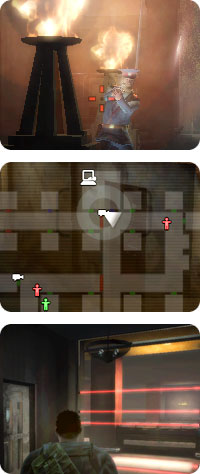By Brad Cook
DATELINE: Moscow, Aug. 15, 1986. The cell is cramped. It reeks of the wet smell of decay. Bad things happened here in the past. Let’s just say I’ve had better accommodations.
A mere 12 hours ago, I was on a plane bound for Moscow, thanks to a tip from my old pal Sergei. Something about a meeting between the Soviet president and a CIA agent at the mausoleum where they keep Lenin’s casket. Sounded like a great photo op, along with a likely cover story when I returned.
Setting the Stage

Getting into the mausoleum wasn’t too difficult. A few guards were hanging around, of course, but I managed to give them nice naps courtesy of the rubber bullets I cobbled together from some plastic bottles and regular bullets. I wasn’t about to give anyone The Big Sleep, I just wanted to do my job.
I dispatched the guards inside the mausoleum the same way and found a cozy spot where I could watch the meeting. I had my trusty camera ready to document the big event. I could hear them announcing my name as a Pulitzer Prize nominee.

Then something went seriously wrong. Some guy and the Soviet president were there, along with a woman. I figured Sergei could help identify the unknown participants, so I prepared to snap a shot. That’s when I realized my camera had been switched sometime after I arrived: I saw everything as if it was an x-ray.
Taking a Wrong Turn
I had a hunch that clicking the button while the camera was pointed at people might not be a good idea, so I decided to see what would happen with a fire extinguisher. Okay, it wasn’t the smartest move, but I discovered that my new toy did indeed possess a lethal ability.
After the fire extinguisher exploded, a guy named Barinsky burst into the room, along with a few of his Spetsnaz (Russian special forces). It turned out that the meeting involved Alexander Grushkov, the head of the presidential guard, and Sonya Yakovleva. Barinsky announced that they arranged the get-together so I could assassinate the president. Of course, he’s the head of the KGB, so who’s the president going to believe?
He also claimed that I secretly work for the CIA. I didn’t have time for that bombshell to sink in, though, because I had no plans for a Siberian vacation. I pointed the camera at another fire extinguisher and clicked, using the confusion to slip away. Getting out of the mausoleum wasn’t easy, but the camera proved useful for figuring out where the guards were located. My rubber bullets also came in handy for moments when I couldn’t sneak around the bad guys. And I evaded those security cameras with ease.
I knew my engineering expertise would come in handy one day.
From Frying Pan to Fire
Escaping the mausoleum should have ended this nightmare, but as you already know, it didn’t work out that way. Just when I thought I was home free, Barinsky’s car popped out of the darkness. He ran me down and knocked me out.
I woke up in this cell, missing all my possessions except a pencil stub and scrap of paper. They stuck Grushkov in the cell across from me. He says we’re in Lubyanka, the infamous KGB headquarters.
Then a few minutes ago, he overpowered a guard, knocked him out, and took the keys. We’re free, but I don’t know how far I can trust this guy. He’s telling me to come with him. He knows the layout of this place and I don’t. That gives him an advantage I could never have on my own.
I know I need to follow him, but something is seriously rotten in the state of Denmark. I just hope the play’s the thing for Grushkov, and we can expose Barinsky’s subterfuge. If you’re reading this, we succeeded. But it wasn’t easy.



